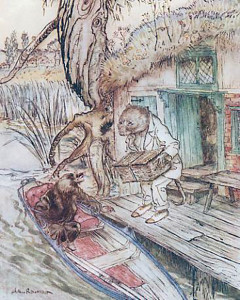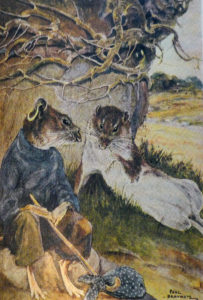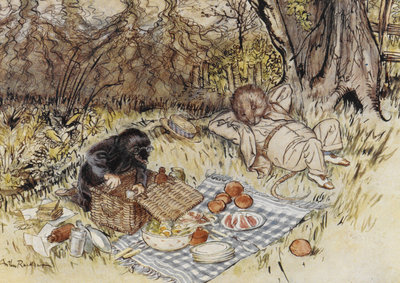Grahame’s picnic in The Wind in the Willows (1908) is a wonder. What child (or adult) could ever conceive of a picnic for one eating basket full of “cold chicken. . .‘coldtonguecoldhamcoldbeefpickledgherkinssaladfrenchrollscresssandwichespottedmeatgingerbeerlemonadesodawater——’?” *

Arthur Rackham. “Shove That Under Your Feet He Observed to the Mole as He Passed it Down into the Boat,” (1931.
It’s the adults that prefer oceans of food for picnics believing that this is the best way (some think the only way) to fulfill expectations for a successful picnic. Amazingly, though Ratty presumably packed for himself alone, Water Rat’s wicker basket is so full that he can hardly lift it into his boat. When Mole meets Ratty, he is immediately invited to share the picnic. Not yet understanding what a picnic is or its customs, Mole is surprised and delighted. But he learns quickly, and when he is permitted to unpack the mounds of food, Mole is astonished and burbles with joy, “O, my! O, my!” as each new packet of food is discovered and arranged on the cloth. The seamless description of the foods is appropriate for a picnic meal because picnic food is always served simultaneously, unlike a home or restaurant meal. Keeping to Ratty’s gentlemanly gormandizing, they dine on plates and use flatware. Ratty tends to be posh and sometimes lazy, so he slyly lets Mole do most of the cleaning, too.
Ratty’s picnic is held in early spring, a traditional time for getting out of the house and into the natural world. The season is all leisure for Ratty, and he takes his ease “messing around boats” and picnicking. Mole is a workaholic, but this spring, he drops his earnest dedication to house-cleaning deep in the earth and spur of the moment, he looks up at the sky and the river, neither of which he knows from experience.

Paul Bransom.S “It’s a Hard Life by All Accounts,” murmured the Rat,” (1913).
*The menu is Cold Tongue, Cold Ham, Cold Beef, Pickled Gherkins, Salad, French Rolls, Potted Meat, Ginger Beer, Lemonade, and Soda Water. Compare this with W.C. Fields’s menu for a three-day picnic.
Featured Image: E.H. Shepard. The River Bank (1931, colorized 1959)
See Kenneth Grahame. The Wind in the Willows. London: London: Methuen and Company, 1908

